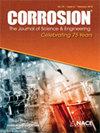电镀-热浸镀锌锌镍合金涂层钢的表面表征、力学性能和腐蚀行为
IF 1.3
4区 材料科学
Q4 MATERIALS SCIENCE, MULTIDISCIPLINARY
引用次数: 0
摘要
本研究研究了在普通碳钢(St37)表面先镀镍层再热镀锌的锌镍合金的加工工艺。研究了镍层和浸泡时间对镀层合金层的影响。此外,利用光学显微镜、扫描电镜、EDX分析和恒电位仪对涂层的整体厚度、硬度、表面均匀性、涂层附着力、耐蚀性等性能进行了研究。结果表明:16 min的浸锌时间是形成含镍量为0.11 wt.%合金的最佳镀锌时间,且与纯锌片相比,镀锌板的整体厚度,尤其是合金层厚度减小。此外,获得了更强的延展性,耐腐蚀性和光滑的表面。本文章由计算机程序翻译,如有差异,请以英文原文为准。
Surface characterization, mechanical properties and corrosion behavior of Zn-Ni alloy coated steel using electro plating-hot dip galvanizing
ABSTRACT In this study, the processing of zinc-nickel alloys with an electroplated nickel layer as the first layer followed by hot-dip galvanizing on plain carbon steel (St37) is investigated. The effect of the nickel layer and the effect of the immersion time on the alloy layers of the coating obtained by this method are studied. In addition, some properties of the obtained coating, such as the overall thickness, hardness, surface uniformity, coating adhesion strength, and corrosion resistance, were investigated using the optical microscope, scanning electron microscope, EDX analysis, and potentiostat. The results show that the 16-minute immersion time is the optimum galvanizing time at which an alloy with a nickel content of 0.11 wt.% is formed, and that the overall thickness of the galvanized sheet, especially the alloy layers, decreases compared to the pure zinc sheet. In addition, a more ductile, corrosion-resistant and smoother surface is obtained.
求助全文
通过发布文献求助,成功后即可免费获取论文全文。
去求助
来源期刊

Corrosion
MATERIALS SCIENCE, MULTIDISCIPLINARY-METALLURGY & METALLURGICAL ENGINEERING
CiteScore
2.80
自引率
12.50%
发文量
97
审稿时长
3 months
期刊介绍:
CORROSION is the premier research journal featuring peer-reviewed technical articles from the world’s top researchers and provides a permanent record of progress in the science and technology of corrosion prevention and control. The scope of the journal includes the latest developments in areas of corrosion metallurgy, mechanisms, predictors, cracking (sulfide stress, stress corrosion, hydrogen-induced), passivation, and CO2 corrosion.
70+ years and over 7,100 peer-reviewed articles with advances in corrosion science and engineering have been published in CORROSION. The journal publishes seven article types – original articles, invited critical reviews, technical notes, corrosion communications fast-tracked for rapid publication, special research topic issues, research letters of yearly annual conference student poster sessions, and scientific investigations of field corrosion processes. CORROSION, the Journal of Science and Engineering, serves as an important communication platform for academics, researchers, technical libraries, and universities.
Articles considered for CORROSION should have significant permanent value and should accomplish at least one of the following objectives:
• Contribute awareness of corrosion phenomena,
• Advance understanding of fundamental process, and/or
• Further the knowledge of techniques and practices used to reduce corrosion.
 求助内容:
求助内容: 应助结果提醒方式:
应助结果提醒方式:


